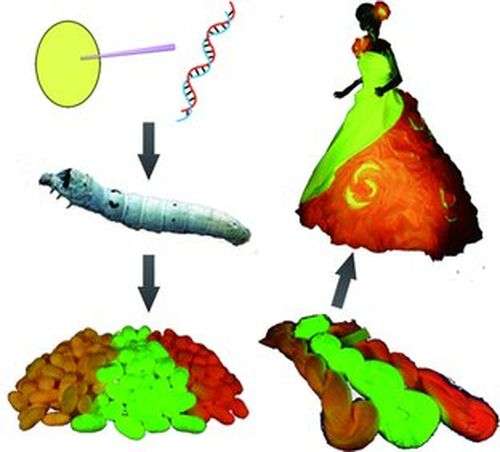June 21, 2013 report
GM silkworms bred to spin fluorescent

(Phys.org) —Scientists in Japan have genetically engineered silkworms to create red, green or orange silks that glow under fluorescent lights.
The silkworm is the larval form of the domesticated silkmoth (Bombyx mori) and is one of only two insects domesticated by humans (the other being the bee). The larvae build a cocoon around themselves in which to pupate, and each cocoon is made from a fine protein thread of silk up to 900 meters in length. Silk is made by harvesting the cocoons (with larvae inside) and softening them so the threads can be reeled. Around 6,000 cocoons are needed to make a kilogram of silk. Normal silk is a soft, white thread.
Now a research team led by Tetsuya Iizuka and Toshiki Tamura of the National Institute of Agrobiological Sciences in Ibaraki, Japan, has genetically modified the silkworm by transplanting genes from organisms that produce fluorescent proteins into the silkworm genome at the site coding for the silk fiber protein fibroin. The genes they used to make the transgenic silkworms came from the Fungia concinna coral (orange), Discoma coral (red) or jellyfish (green).
Silkworms had previously been genetically modified to produce human collagen proteins and spider silk. Co-author Tamura, said they had earlier produced green fluorescent protein that was used to make beautiful silks, and the new research extended the method to produce the three fluorescent silks in large enough amounts to be useful in making fabrics.

The colored silk made by the over 20,000 transgenic silkworms raised in the lab has been demonstrated to remain vibrant in color under fluorescent light for over two years. In other types of light the colors are less noticeable.
Turning the threads into a fabric presented another challenge for the team because the normal method of producing silk (heating cocoons to 100 degrees C) destroys the fluorescent proteins. Their experiments showed that the cocoons could be softened and reeled by using a weak alkaline solution and heating them to lower temperature in a vacuum. Tamura said this more complex process would mean the fabric would be slightly more expensive than ordinary silk.
The silk produced is a little weaker than normal silk, but it is already finding its way into clothes such as suits, ties, and even wedding dresses. Tamura expects it might also be useful in areas such as silk for medical applications.
Other scientists have created colored silks by feeding dyes to non-genetically modified silkworms, but the new method means that transgenic silkworms can be bred and fed their normal diet of mulberry leaves.
The paper was published in the journal Advanced Functional Materials.
More information: Iizuka, T., Sezutsu, H., Tatematsu, K.-i., Kobayashi, I., Yonemura, N., Uchino, K., Nakajima, K., Kojima, K., Takabayashi, C., Machii, H., Yamada, K., Kurihara, H., Asakura, T., Nakazawa, Y., Miyawaki, A., Karasawa, S., Kobayashi, H., Yamaguchi, J., Kuwabara, N., Nakamura, T., Yoshii, K. and Tamura, T. (2013), Colored Fluorescent Silk Made by Transgenic Silkworms. Adv. Funct. Mater.. doi: 10.1002/adfm.201300365
Abstract
Silk is a protein fiber used to weave fabrics and as a biomaterial in medical applications. Recently, genetically modified silks have been produced from transgenic silkworms. In the present study, transgenic silkworms for the mass production of three colors of fluorescent silks, (green, red, and orange) are generated using a vector originating from the fibroin H chain gene and a classical breeding method. The suitability of the recombinant silks for making fabrics is investigated by harvesting large amounts of the cocoons, obtained from rearing over 20 thousand silkworms. The application of low temperature and a weakly alkaline solution for cooking and reeling enables the production of silk fiber without loss of color. The maximum strain tolerated and Young's modulus of the fluorescent silks are similar to those of ordinary silk, although the maximum stress value of the recombinant silk is slightly lower than that of the control. Fabrics with fluorescent color are demonstrated using the recombinant silk, with the color persisting for over two years. The results indicate that large amounts of genetically modified silk can be made by transgenic silkworms, and the silk is applicable as functional silk fiber for making fabrics and for use in medical applications.
via Wired
Journal information: Advanced Functional Materials
© 2013 Phys.org




















